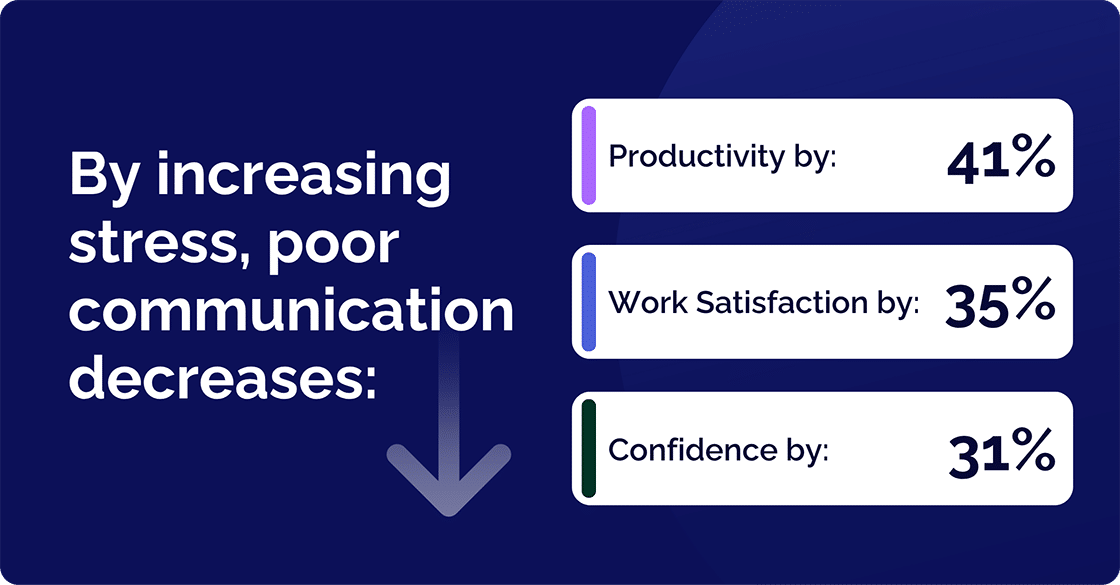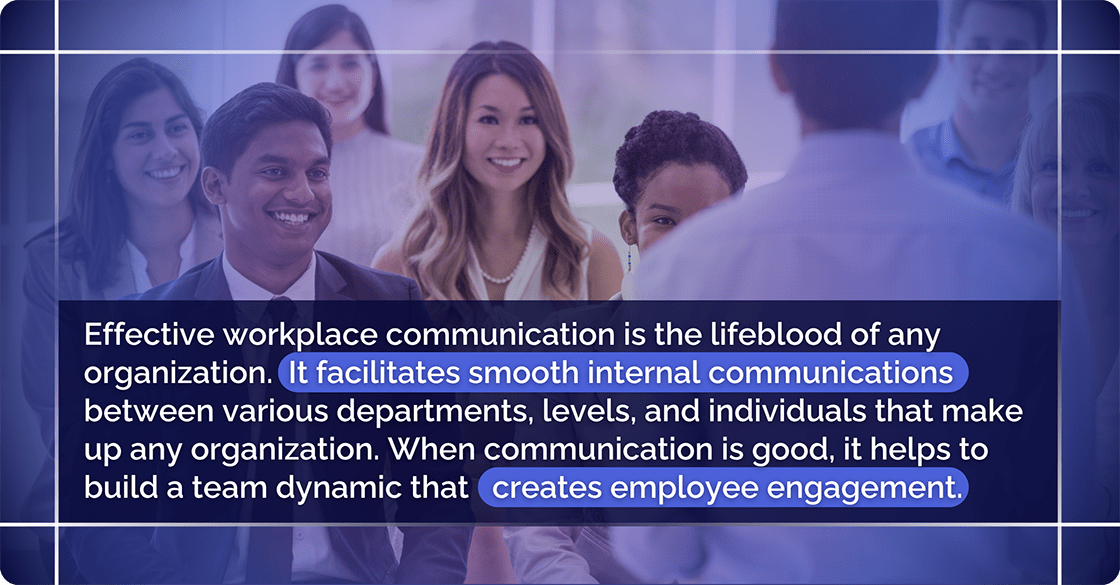Poor communication can have a devastating impact. It leads to low morale and decreased productivity. Turn your internal communications around today.

.webp)
Effective internal communication is the backbone of every successful organization. Learn the ins and outs of internal communications with our research-backed white paper.
Access Now
In 2022, ineffective communication in the workplace was costing U.S. businesses up to $1.2 trillion every year, according to The Harris Poll and Grammarly for Business 2024 State of Business Communication report. Since the repercussions of poor communication are worsening, clearly this figure will have risen. The report states that overall stress at work had climbed to 16%. Alarmingly, most knowledge workers (97%) experience stress at work, with 51% rating their stress as a 7 or higher on a scale of 1 to 10. Furthermore, more than half of knowledge workers (51%) report that they or their team have experienced increased stress at work due to poor communication.
By increasing stress, poor communication decreases productivity by 41%, work satisfaction by 35%, and confidence by 31%. On the other hand, according to the report, effective communication decreases stress by 48%, and increases productivity by 55%, work satisfaction by 58%, and confidence by 55%.

“The challenges and opportunities in communication are more apparent than ever in 2024, prompting business leaders to address the critical need for effective communication across generations and geographies.”
2024 State of Business Communication
With this in mind, we’re going to explore ways to solve poor communication issues and improve communication in the workplace.
In stark contrast to effective communication, which produces positive results, poor communication results in messages not being adequately decoded or understood. This can cause confusion and frustration and often results in errors. It is typically characterized by ambiguity, lack of clarity, inconsistencies, and misinterpretations.
But there are many different reasons why communication is mediocre or even sub-standard. For example, poor communication can be the result of weak language skills, lack of attention, misunderstanding nonverbal communication such as facial expressions and body language, or not considering cultural differences. It may also stem from using inappropriate communication software or channels, a general lack of transparency, or because of ineffective listening skills on the part of the communicator or the recipient.
David Grossman, CEO of The Grossman Group, a communications consultancy, defines poor communication as “a breakdown that results from a discrepancy or disconnect between what is said and what is understood. This lack of mutual understanding can happen at the interpersonal level between colleagues or at an organizational level.”
Gallagher’s 2025 Employee Communications Report drawn from the results of the company’s State of the Sector 2024/25 survey, identifies poor communication as one of the top five barriers for 2025. They ask the question, Are leaders listening to communicators' advice? One in three respondents stated that leadership comms coaching was a top priority for 2025 with 45% saying leadership comms coaching was a highly important skill for communicators to have in 2025.
While 87% of respondents said they proactively approach leaders with advice on how to communicate, a smaller percentage (70%) said that leaders implement their advice. The proviso was that the communicators who interacted with leaders more frequently and had a collaborative relationship with leaders, were more likely to have leaders heeding their advice.
Effective workplace communication is the lifeblood of any organization. It facilitates smooth internal communications between various departments, levels, and individuals that make up any organization. When communication is good, it helps to build a team dynamic that creates employee engagement. It is also instrumental in minimizing misunderstandings, enhancing productivity, and promoting healthy workplace relationships.

Effective communication is more than just passing information onto employees. It involves meaningful interpretation and understanding. The role of facial expressions, eye contact, body language, tones, and postures in nonverbal communication cannot be over-emphasized. They add depth to words, offering cues about emotions and attitudes, affecting the communication process positively or negatively.
Poor communication not only impacts the working atmosphere. It also affects personal interactions and relationships among colleagues and affects overall team dynamics and trust.
However, recognizing poor workplace communication is simpler than you might think. It can be done by being watchful of common signs and symptoms like:
Identifying these signs early allows organizations to take corrective action before poor communication becomes a long-term barrier to success.
Turn your internal communications strategy around today

Poor workplace communication often leads to grave consequences that ripple through an organization. Misinterpretations, wrong assumptions, and misunderstandings are just a few results of ineffective communication. They can result in tension, loss of morale, and wasted effort. For this reason, management and leaders need to understand and address the impact of inadequate communication.
The consequences are far-reaching. Misunderstandings and conflicts can create unnecessary tension between teams and individuals, disrupting collaboration. Productivity often suffers, as employees struggle to meet deadlines or duplicate work due to unclear instructions. Employee morale drops, particularly when poor communication makes individuals feel overlooked or undervalued. Over time, this leads to disengagement, increased turnover, and reduced job satisfaction. In addition, poor communication may cause missed opportunities for innovation or improvement, and strained relationships within and across departments. Finally, increased errors and associated costs, including legal or compliance risks, can severely impact business performance.
One of the primary impacts of poor communication is its detrimental effect on the morale and engagement of the team. When there’s a lack of clear, concise, and consistent information, employees tend to feel disconnected, unsure, and unmotivated. This disconnection interferes with employees’ emotional management, making it hard for them to find satisfaction and engagement in their roles.
Good communication boosts morale by helping employees feel valued, informed, and involved. But, when communication is poor, it may lead to confusion, frustration, and a decrease in employee commitment and loyalty.
Poor communication can profoundly impact an organization’s culture. When there’s a lack of communication or miscommunication it can lead to suspicion, cynicism, and a lack of trust among team members. This negative environment can easily bleed into interactions between departments, suppliers, and clients, affecting the image of the organization and its reputation.
Clear and transparent communication, on the other hand, cultivates a culture of trust and openness. Good communication fosters an environment where employees feel comfortable asking questions, sharing ideas, and voicing concerns. Therefore, rectifying these communication issues is a vital aspect of cultivating a positive organizational culture and is key when you need to solve poor communication problems.
Poor communication also takes a significant toll on productivity and the ability to collaborate effectively. When information is not accurately or efficiently conveyed, tasks may be performed incorrectly, deadlines missed, or worse still, work duplicated. This confusion and wasted effort significantly diminish productivity.
The key to promoting productivity and collaboration lies in good quality internal communications. Involved, informed, and passionate employees are undoubtedly more productive and engaged. Moreover, they tend to develop better team communication, in this way promoting a more cooperative and harmonious work environment.

Understanding the theory behind poor communication is one thing. Recognizing it in real-life workplace situations is another. These examples show how ineffective communication can quietly (and often quickly) erode productivity, morale, and trust across teams.
These scenarios are examples that highlight how everyday communication missteps can escalate into larger problems if left unaddressed.
Turn your internal communications strategy around today

To tackle the negative effects of poor communication, organizations need to adopt strategic measures. Below are seven ways to minimize poor communication, enhance understanding, and improve synergy in the workplace.
To improve workplace communication, messaging needs to be clear and consistent. This involves creating and disseminating essential information using specific language that is easy to understand. Doing this keeps teams effectively engaged, while misunderstandings are minimized, and employees can perform their roles more efficiently.
Effective communication is not just about conveying messages, it also depends on active listening. Promoting this key aspect of communication assists managers and leaders in understanding employees’ needs, concerns, and suggestions, helping to significantly minimize miscommunication.
With advancements in technology, it has become pivotal to incorporate modern and suitable communication tools in the workplace. Whether it’s via email, messaging apps, video calling, or a modern intranet, digital tools can significantly improve internal communication by speeding up the process and making it more manageable and effective.
To ensure effective communication, it is crucial to establish open and transparent communication channels. Channels like team meetings, allow a two-way flow of information where employees can voice their opinions and leadership can offer feedback, and promote open and effective communication.
Providing regular communication training is an excellent way of enhancing workplace communication and solving issues that result from poor communication. Training that focuses on nonverbal communication signals like eye contact and facial expressions, as well as emotional intelligence, and empathy, are of great value. Training sessions can help employees understand the perspectives of others better. They can also help to improve methods of conversations in different scenarios and situations.
Promoting a culture of open feedback is another essential step toward reducing poor communication. When employees feel respected and heard, they are more likely to express their thoughts and ideas, contributing to a more harmonious working environment.
The implementation of regular assessments helps internal communicators and team leaders measure the effectiveness and success of communication practices. Assessments can also evaluate whether they align with organizational goals. They allow for the identification of areas of improvement and the development of strategies to enhance employee communication and, subsequently, the overall success of the organization.
These seven steps, when implemented correctly, can significantly minimize poor communication, leading to improved morale, a positive organizational culture, and increased productivity.
But it’s important to remember that effective communication is an ongoing process and it requires commitment from all levels of the organization.

Leadership plays a pivotal part in fostering effective workplace communication by setting a tone, cultivating a culture of openness, and implementing effective communication channels within an organization. In essence, leaders are the torchbearers who can either facilitate or hinder communication, based on their approach and understanding of its critical importance.
To maintain a cohesive environment that encourages dialogue and transparency, leaders must adopt a proactive stance in dealing with potential problems of poor communication. They can embody good communication habits, first and foremost, but fostering a conducive atmosphere for open and honest discussion also falls primarily within their purview.
The impact of leadership on workplace communication is most evident when they serve as guardians of the organization’s communication climate. This affects the overall atmosphere or environment created by patterns of communication within a group, organization, or relationships between individuals. It encompasses the tone, openness, trust, and receptivity to ideas, fostering either a positive or negative environment for communication to be effective.
A strong leader can improve communication by proactively facilitating open dialogue, recognizing employees’ contributions, encouraging feedback, and promoting transparency.
A leader’s behavior significantly shapes the internal communication patterns within the team. For instance, a leader who regularly stays in touch with team members, maintains eye contact and uses appropriate facial expressions during conversations, encourages a sense of openness. This, in turn, makes employees feel connected and more comfortable in sharing their thoughts and ideas.
Let’s consider a few key aspects that relate to the role of leaders in workplace communication:
Poor communication is often the result of inconsistent messaging, siloed channels, and a lack of employee engagement. Cerkl Broadcast is designed to overcome these challenges by offering a powerful, AI-driven internal communication platform and a centralized hub that meets the needs of organizations of any size or complexity. With Broadcast, companies can streamline messaging, reach employees wherever they are, and track communication effectiveness in real-time.
One of Broadcast’s standout features is its omnichannel delivery. Whether employees prefer email, a mobile app, Microsoft Teams, Slack, or intranet notifications, Broadcast ensures messages are delivered seamlessly across all platforms, eliminating the risk of missed updates and disconnected experiences. This is especially valuable for remote, hybrid, and deskless workers.
Broadcast’s audience segmentation tools allow communicators to personalize messages based on role, department, location, or even engagement behavior. This prevents information overload and ensures employees only receive messages relevant to them, making communication more targeted, timely, and meaningful.
With AI-powered Email Blasts and News Digests, internal teams can automate updates while maintaining control over tone, timing, and branding. These blasts can be scheduled in advance and customized for different audience segments, ensuring clarity and consistency across every layer of the organization.
The platform also includes robust analytics and reporting features. Communication professionals can track open rates, click-throughs, and engagement trends, and even compare message performance across channels. This data provides valuable insights into what’s working — and what’s not — so teams can continuously improve their messaging strategy.
Cerkl Broadcast doesn’t just facilitate communication, it elevates it. By enabling a more connected, informed, and responsive workforce, Broadcast helps organizations eliminate the root causes of poor communication and build a culture of transparency, engagement, and trust.
If poor communication is a problem in your organization, consider switching to Broadcast.
A good way to start is with our free white paper, The Importance of Internal Communication, which will give you lots of guidance and will help you turn your internal communications strategy around today.

Turn your internal communications strategy around today
What is poor communication? Poor communication refers to the ineffective, unclear, and sometimes completely incompetent exchange of information between individuals or groups that usually leads to misunderstandings or misinterpretations.
How do you deal with poor communication? Dealing with poor communication, to overcome it, involves actively listening, seeking clarification, expressing thoughts clearly, and fostering an open and honest communication environment.
What behaviors are considered poor communication? Behavior that most people consider to be poor communication includes interrupting others, avoiding eye contact, using unclear language, not actively listening, and failing to provide feedback.
What are 5 bad communication skills? While you can’t consider something that is bad to be a skill, there are ways people operate that show a decided lack of communication skills. They include a general lack of clarity when trying to communicate, poor listening, inconsistencies related to non-verbal communication, an inability to adapt communication style, and avoiding feedback or conflict resolution.

Turn your internal communications strategy around today